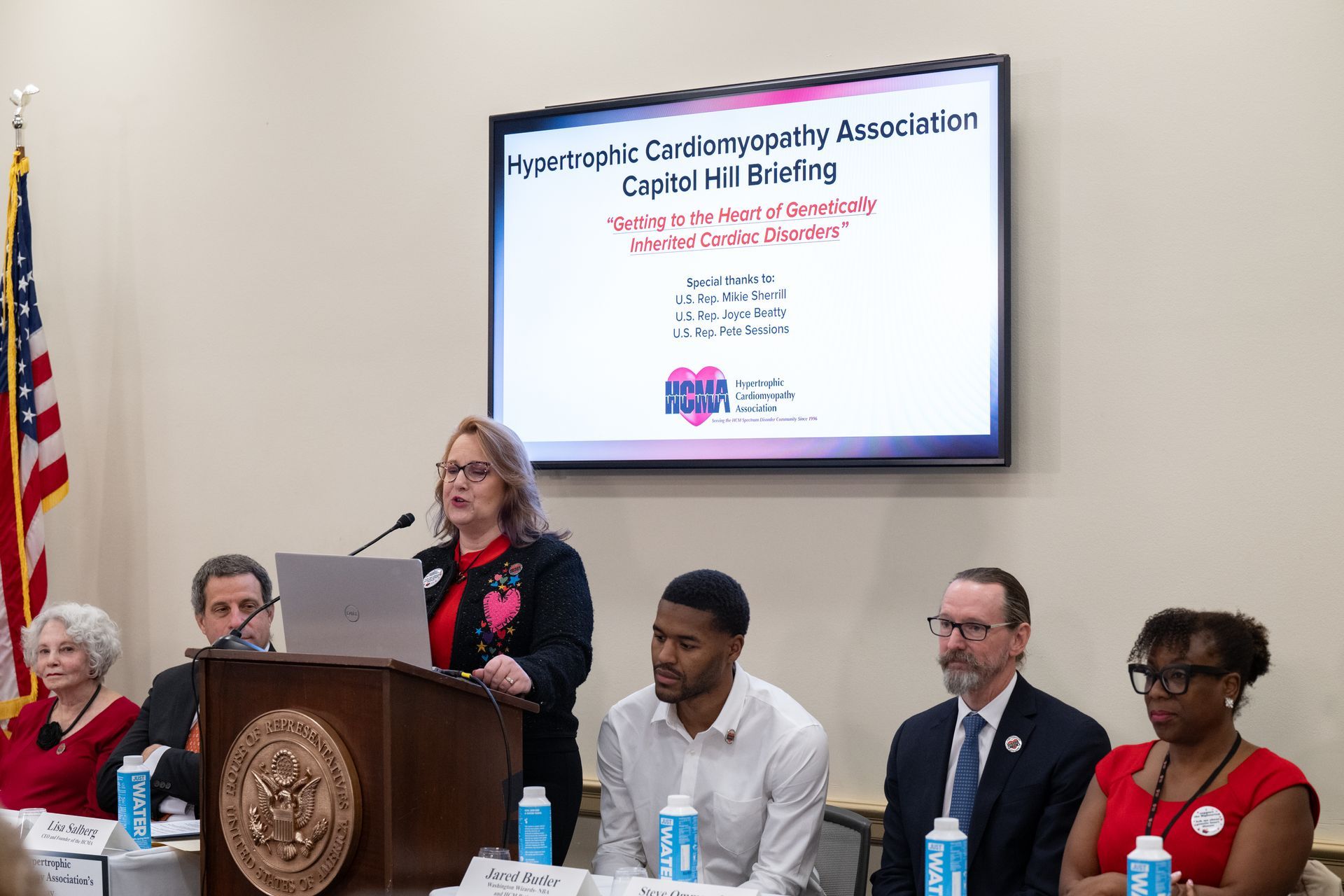Pompe Disease
A glycogen storage disorder
What is Pompe Disease?
Pompe Disease is very rare. It is usually diagnosed in infancy, but it can be diagnosed later. Almost all cases of Infantile Pompe involve the heart, with 92% having the appearance of HCM. About 12 of every 100 adult Pompe patients have a heart problem, usually "HCM". Pompe also causes muscle weakness, skeletal problems, gut problems, and hearing issues.

Pompe Disease is a very rare muscle disorder. It affects many body systems, can progress quickly, and can cause early death. Symptoms can be debilitating. It is also known as Acid Maltase Deficiency (AMD) or Glycogen Storage Disease Type II (GSD-II). Muscle weakness affects the whole body, including the heart and lung muscles.
What Causes Pompe?
Lack of an enzyme allows glycogen to build up, which may lead to muscle damage and premature death. Glycogen is a complex sugar stored in lysosomes. Acid alpha-glucosidase, or GAA, helps to break down glycogen into glucose. Cells use glucose (a simple sugar) for energy. Because there is little or no GAA to break down sugars, muscle cells become weak and damaged. Cells use lysosomes as recycling trucks to help remove what the cell doesn't need. When there are problems with the lysosomes, they don't work right. Imagine the recycling truck is low on gas, and the engine isn't running well.
Genetics
Pompe is caused by a recessive mutation in the GAA gene. Both parents must have the mutation for their child to develop the disease. One-fourth of children from two parents with the mutation will have Pompe. One-fourth will not have a mutation, and half of children will be carriers. The change in the GAA gene causes cells to be unable to remove unneeded glycogen from lysosomes.
Genetic Testing / Newborn Screening
Some countries, including the US, include Pompe testing in routine newborn screenings. This helps identify patients earlier so that treatment can begin quickly. The sooner treatment begins, the better the outcomes will be. Newborn screening is not a complete diagnosis; it is just a hint that Pompe may be present. More testing would be needed for any baby who screens positive. Genetic testing at any age is the best way to diagnose Pompe.
How is Pompe like HCM?
Most infants with Pompe have enlarged hearts (hypertrophy or cardiomegaly). The thickened heart muscle can look like HCM. Those with Infantile Pompe usually develop hypertrophy within the first weeks of life. Those with late-onset Pompe may have thick hearts and heart rhythm issues similar to HCM. For these reasons, Pompe is considered an HCM spectrum disorder.
The age of diagnosis determines the severity of the disease and the lifespan of the patient
Infantile Pompe
Classic Infantile Pompe, diagnosed by 3 months of age, is often fatal by age one to two if left untreated. There is also a slower-moving infantile type. Current treatments are leading to longer lives in these babies. Those with infantile Pompe have little to no GAA activity.
Non-Classic Infantile Pompe
Children diagnosed after age one often have enlarged hearts, but not before age one. Without treatment, these babies live until early childhood. Current treatments allow them to live much longer and with a better quality of life.
Later-onset Pompe
Later-onset Pompe, diagnosed as a child or an adult, has fewer and less serious symptoms. These patients rarely have heart problems from Pompe. Those with later-onset Pompe have some GAA activity. Symptoms are often muscle weakness of the legs, trunk, and diaphragm. The earlier symptoms start, the faster the disease tends to progress.
How is the heart in Pompe Monitored?
Echocardiogram
An echocardiogram to screen for HCM should be done at diagnosis. If HCM is found, the echo should be repeated annually or as needed due to symptoms.
Chest X-Ray
A chest x-ray to check the heart, lungs, and spine may be done at the initial diagnosis and annually after that.
MRI/CMR
A cardiac MRI (CMR) should be done at diagnosis to screen for any heart problems, then as needed due to symptoms. In late-onset patients, this is optional based on the echocardiogram findings.
EKG/ECG
Pompe may cause shortened PR interval and tall QRS complexes. Patients may develop abnormal heart rhythms. EKG should be done at the initial diagnosis, then as needed due to symptoms.
Holter or Ambulatory Heart Monitor
A 24-hour Holter monitor monitor should be done at diagnosis and repeated based on age. In infants, this will be at age 6 months, 9 months, then every 3rd year or as needed due to symptoms. In older patients, it should be done every 3 years unless needed due to symptoms.
Laboratory Tests
If the heart is involved, BNP or NT-Pro BNP is a blood test that will be done to track how well the heart is working.
Family Screening/Family Planning
Family members of a person with Pompe will be offered genetic testing to see if they carry a mutated GAA gene. If they do, they can ask their partner to also have a genetic test before having children. If both partners have a mutated GAA gene, they might decide to use IVF to screen out Pompe. A genetic counselor can help couples plan their families.
Other affected body systems
Those with later-onset Pompe may develop symptoms besides muscle weakness. These include skeletal problems like scoliosis (a curvature of the spine). There can be breathing issues due to weakness in the muscles that move the lungs. Trouble chewing or swallowing, problems digesting food, and hearing issues are common. Children may have delayed motor development. Patients can have trouble exercising, muscle cramps, headaches, low back pain, and fatigue. Most report pain in at least one part of the body. They often develop shortness of breath, sleep apnea, and respiratory infections.
Misdiagnoses
Pompe disease can be hard to diagnose and may be mistaken for other diseases. Misdiagnoses include muscular dystrophy, spinal muscular atrophy, rigid spine syndrome, and myasthenia gravis. If muscle symptoms are mild and the heart is thick, the patient can be diagnosed with HCM. This is one reason genetic testing is recommended with HCM - to rule out mimics like this.
Outcomes for late-onset Pompe patients
The earlier late-onset Pompe is discovered and treated, the better the outcome will be. Life expectancy can be from childhood to late adulthood. This depends on breathing problems, how quickly the disease progresses, and heart problems.
Enzyme Replacement Therapy
There is no cure for Pompe Disease, but there are treatments. Two enzyme replacement therapy (ERT) drugs are approved in the US to treat late-onset Pompe. These are Lumizyme (alglucosidase alfa), Myozyme outside the US, and Nexviazyme (avalglucosidase alfa). ERT has been shown to improve quality of life and increase patients' lifespan. ERT should be given by centers with expertise in Pompe or other lysosomal diseases.
Combination Therapy
Pombiliti (cipaglucosidase alfa) and Opfolda (miglustat) are approved for adults with late-onset Pompe. Pombiliti is a type of GAA enzyme, and Opfolda is an enzyme stabilizer. The combination helps to improve walking ability and breathing.
Heart Medicines
Medications may be needed to treat heart failure, especially in infantile-onset patients. Infantile-onset patients with cardiomyopathy should avoid some medicines, like digoxin. Angiotensin-converting enzyme (ACE) inhibitors, calcium blockers, and beta-blockers can be used. They should only be prescribed by an experienced pediatric cardiologist.
Team Approach
A team of specialist doctors will be needed to treat the Pompe patient. This is because so many body systems are affected by the disease.
Non-medical therapies
In addition to medications, other therapies can help maintain a good quality of life. These include: physical and occupational therapy, respiratory therapy, and speech therapy. Exercise (after a heart evaluation) and nutrition guidance are crucial.
Don't be afraid to use orthotics or mobility aids such as canes and wheelchairs. Assistive devices for feeding, breathing, and communication can make life easier.
Clinical Trials
Clinical trials are looking at new therapies for Pompe, including gene therapy.
Citations:
The European reference network for metabolic diseases (MetabERN) clinical pathway recommendations for Pompe disease (acid maltase deficiency, glycogen storage disease type II). Orphanet J Rare Dis 2024 Nov, 19 (408).

 Translate
Translate